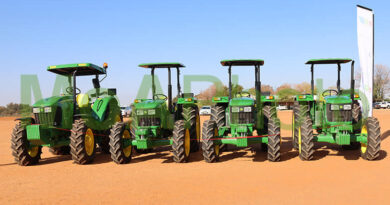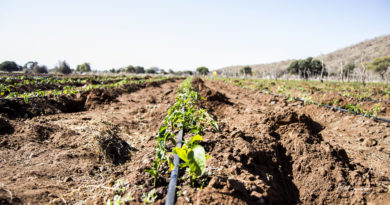Challenges of Dairy Production in Botswana
The Chairman of the National Dairy Producers Association, Frans Viljoen, explains why it is very important for all the stakeholders involved in the dairy industry to come together. He spoke to Rocky Gofamodimo about the problems facing the industry as well as what can be done to solve them.
Despite the obvious demand for milk and milk products in the Botswana, the local dairy industry is one of the most underdeveloped and underperforming sub-sectors in the agricultural industry. The industry is plagued by all sorts of challenges. Currently, the dairy sub-sector’s contribution to the national milk demand is approximately 16%, if not less.
The Dairy Board
Mr Frans Viljoen of Moloko Dairy farm, which is located in Mahalapye, points out that the low milk production is due to lack of quality dairy feeds, high feed prices as well as lack of cooperation between all the stakeholders involved in the industry.
According to Frans, who is also the chairman of the interim committee between dairy farmers and processors, there is an urgent need for a well-established Dairy Board that will be at the forefront of development and promotion of the local dairy sector by influencing policies and programmes meant to enhance it.
The dairy farmers are currently negotiating with processors to implement the dairy strategic plan, which was drawn up with the participation of stakeholders in the dairy industry. It is through this plan that such a dairy board will be created. The board will be mandated by the law to make certain decisions regarding the buying price, importation of milk and other factors that affect the sustainability of the dairy industry.
“This will resolve a lot of problems. It’s an ongoing process and it’s really between all stakeholders to resolve the issues.” He elaborates
Foot and Mouth
Before the Foot and Mouth outbreak which ravaged the Maun region some few years back, Botswana dairy farmers used to produce over 12 million litres of milk, with some individual farms producing as much as 7000 litres per day. In the aftermath of the plague the dairy production figures plummeted and the sector never recovered.
“Everything was closed. We could not import feed. Hundreds of cows died and we didn’t get any compensation from government. Some farmers went bankrupt.” Remembers Frans.
Dry Cows
When Viljoen bought two dairy cattle in 2001, it was just for home consumption. He soon realised it was something worth pursuing as a business and he consequently went commercial. He notes that part of the problem why the dairy industry is not performing well locally is due to a high proportion of dry cows kept on farms. “Farmers have to optimise performance in their enterprises.” He emphasizes.
Recent estimates show that milking cows account for about 30% to 40% of the dairy cow herd, which explicitly shows that dry cows outnumber milking cows. Frans himself currently milks about 20 from his 64 cows. This comes at a cost to a farmer as he still has to feed and maintain dry cows. He used to milk most of his cows but had to stop as prices they get from the local market is basically a rip off.
Currently the cost of production stands at about P6.10 per litre while the market price is P5.30 per litre. This shows that farmers are not making profit, not even breaking-even.
“These are some of the things we are discussing with processors to try and fix.” He elaborates.
Feed and Nutrition
The major expense of dairy farming in Botswana is feed. The country is mostly arid with highly unpredictable and erratic rainfall which results in recurring droughts. This leads to lack of quality feed to sustain milk production, forcing farmers to supplement. Compared to the beef industry, dairy animals are affected more by shortage and the quality of feed as they require feed for milk production. With good feed, dairy cows can produce up to 20 litres of milk per cow per day.
“What you get out is what you put in. Poor feed means poor milk production.” explains Frans.
High feed costs results in poor nutrition of animals which in turn contributes to cows becoming dry. Sometimes due to poor feeding, dairy cows do not come on heat in time leading to failure of impregnation. In dairying, if a cow misses just one fertilisation, it misses the whole production cycle and will only calf the following year.
Although farmers can get significant quantities of feed from different regions both locally and from South Africa, the long distances between dairy farms and feed producers results in farmers incurring exorbitant transportation costs.
In South African, farmers produce their own feed and that is why they are able to produce lots of milk at low prices. Most farmers there produce up to 80% of their feed.
“We need such in Botswana. If we can produce our own feed, then our production costs will go down.” Says Frans.
To produce feed farmers need land and only government can help farmers with this issue. Mr Viljoen also feels that government should try all it can to assist farmers who are already operating instead of bringing in new players who are going to face the very same challenges the current guys are facing.
“Government must work with us to resolve the current challenges first. They must assist us to get land, implement policies and agreed strategies then other players can come on board.” Emphasizes Frans.
He however goes on to explain that the problem with Botswana is that even if you are fortunate enough to secure land, water becomes an issue, and if it is not water, the available land is usually un-serviced with no access roads or very far from civilization.
Dairy Breeds
Another problem facing farmers is the shortage of quality dairy breeds adapted to local conditions. Frans believes that there is an urgent need to breed animals that are adapted to Botswana’s climate. To try and combat this problem, Mr Viljoen keeps hybrids of different dairy cows. He calls them the Rainbow Herd. Each and every cow in his farm probably has a mixture of Brown Swiss, Friesians, and even Jersey flowing in their blood. His cross breeding is aimed at trying to improve functional traits and production traits between breeds with high milk production, and those with good fertility and health thereby increasing the viability of his dairy production enterprise.
Market
All the major milk processors are found only in Gaborone and this poses a problem to farmers. Apart from transportation costs, dairy farmers face situations where they receive low payment after delivering milk due to what processors say is poor milk quality. While the poor quality of milk may be ascribable to farmers ignoring simple dairy operation procedures and compromising hygiene standards, those questioning the sincerity of the processors lack second opinion.
As such some farmers feel the processors should only penalize the farmers after confirmation of the status of the milk from the National Veterinary Labs. “This is why as the council we have proposed that the National Veterinary Labs be opened for dairy farmers to utilise.” He emphasizes. When the milk arrives at the processors, a sample can immediately be taken to the labs as soon as delivery is completed for testing.
For a small farmer who wants to sell directly to the retailers, there is a lot of bureaucratic red tape that he has to manoeuvre. One has to bottle, label and barcode. These expenses come on top of production costs.
Mr Viljoen says that although they face challenges regarding the dairy market, they are grateful to Clover as it is the only company which fully supports local dairy farmers by buying their produce.
Hygiene
One other major problem especially for small farmers, and even established dairy producers, is hygiene. Milk is very sensitive and poor hygiene gives rise to high incidences of mastitis, a disease that affects the udder resulting in low milk production. Milk contamination, especially during summer months, is sometimes caused by farmers not cleaning their equipment and machinery as well as cleaning kraals. This milk subsequently fails tests and it is either rejected or fetches low prices. Milk is normally tested for butterfat, total bacteria, protein levels, PH level, anti-biotics as well as somatic cell count among others.
Capital Intensive
Dairy farming enterprises are highly capital-intensive operations, and entry into the industry by new producers requires sound strategies to break even and make profits. Firstly, dairy heifers are expensive, the machinery is also expensive. Feed is expensive. New and beginning producers are faced with challenges of accessing capital as most financial institutions do not want to finance primary dairy production initiatives because of the profitability issue. “Some institutions will say you should start with 200 which I totally disagree with” Says Frans
According to him, farmers must start small and build up their herd. This will enable them to gain experience and learn the pros and cons of the industry without taking much risk at a go. Farmers must set clear goals and objectives, have effective management planning systems, including financial planning in place. They must also develop sound relationships with everyone in the dairy industry value chain if they want their businesses to survive and become profitable.
Without the financial muscle, some farmers end up buying culled animals with poor milk production from neighbouring countries. This is a bad investment in the long run as off springs of such culls will not be productive in terms of milk and that’s why Frans insists upcoming farmers start small and grow their herds over time.
Extension service
There is an inadequate extension service when it comes to dairy farming as opposed to other agricultural sub-sectors. The few available dairy experts are at times inadequately equipped and this has a bearing on the provision of technical assistance to the farming communities, especially small hold farms and start-ups. This has a negative effect on the overall performance of the dairy farms and the quality of milk produced.
Conclusion
“We have revamped the Pitsane Dairy Plant which will be buying milk from local suppliers.” He explains. He also says that they are currently planning to revamp the Serowe Dairy Plant which will go a long way in assisting local farmers. The plan is to have the dairy plants buy milk from producers at an agreed price and then sell to consumers and retailers.
Frans believes that in this way, they will eliminate the middlemen who take their produce for next to nothing. This will also help when it comes to tendering which will be given to the dairy plants instead of the current situation where anyone, even those without a single dairy cow gets tenders. The current arrangement is bad for dairy farmers as some people who win these tenders disappear without paying farmers after receiving payment from government.
Although the local environmental conditions are not favourable to dairy production, Frans is optimistic about the future of the local dairy sector. He believes that if all the key players can get together and implement the National Dairy Strategy, the dairy industry can become self-sustainable.
“I have been in this industry for a long time and I believe in the end we will be able to make dairy production profitable in Botswana.” He says.
He is of the view that if it is provided with adequate support in the form of resources, especially land, and robust appropriate policies by those in power, the dairy industry could provide the much needed employment opportunities, economic diversification as well as poverty alleviation.



